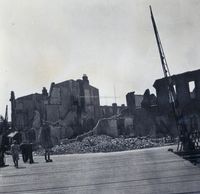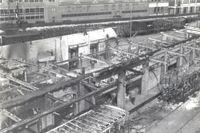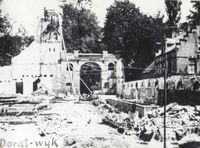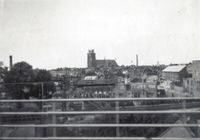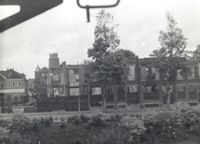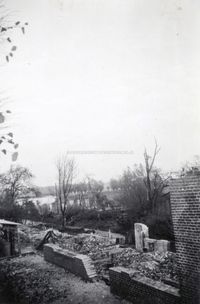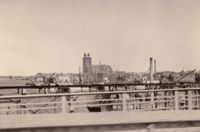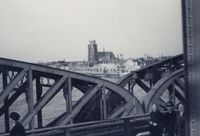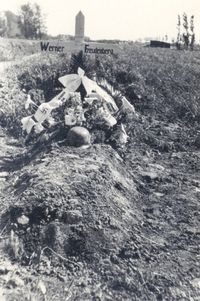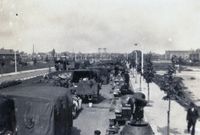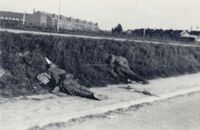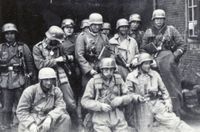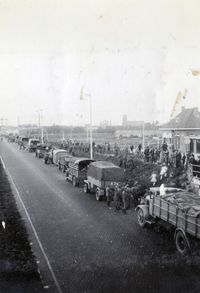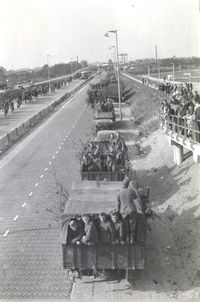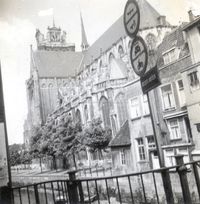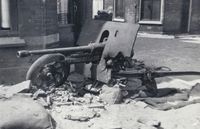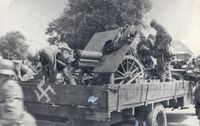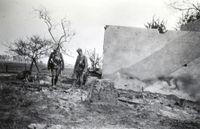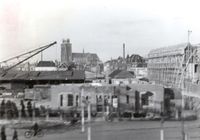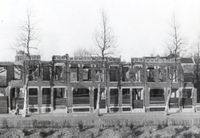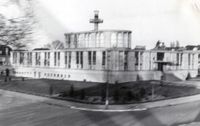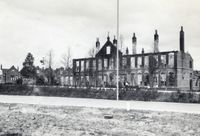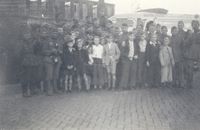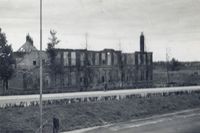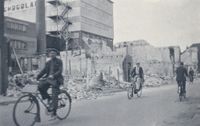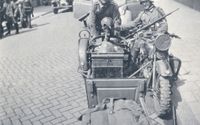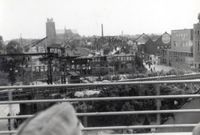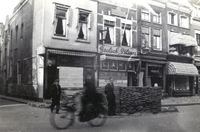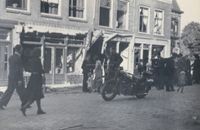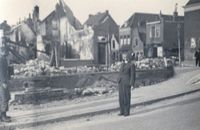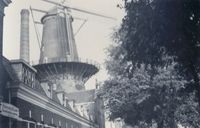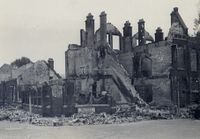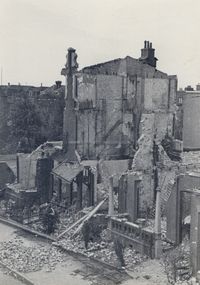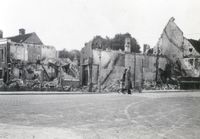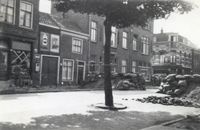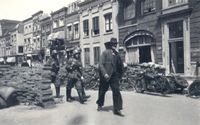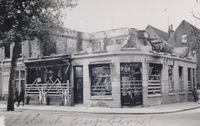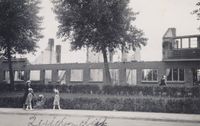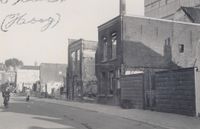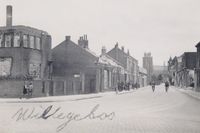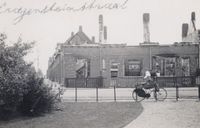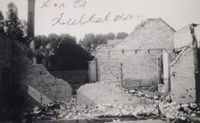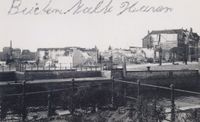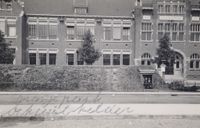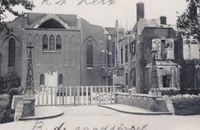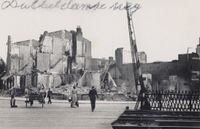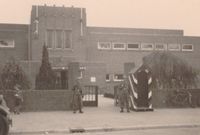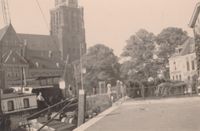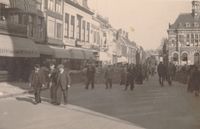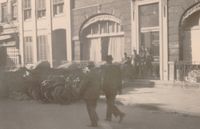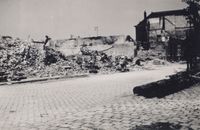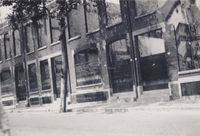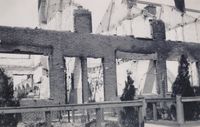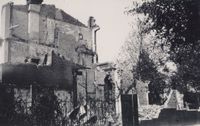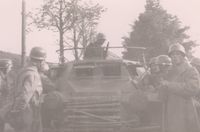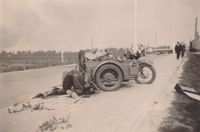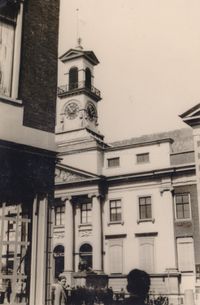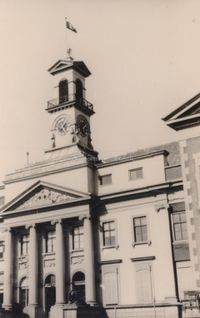Dordrecht and its surroundings - May 1940.
On this page, you will find original photographic material of Dordrecht and its surroundings in May 1940.
Below, you will see various photos of the war damage in Dordrecht as a result of the fighting during May 1940.
In the first photo, you can see the Dubbeldamse weg Zuid in Dordrecht. The houses were destroyed during May 1940. According to eyewitnesses, the houses were destroyed because the Germans threw grenades inside after finding Dutch cartridge cases in a Dutch boy's pocket. However, the houses could also have been destroyed by Dutch artillery. What is certain is that the houses were destroyed during the May battles. *1
The second photo shows the burned-out goods shed at the Spoorweghaven. It was located between the Dutch troops led by second lieutenant Plasschaert, who had taken positions in the Electromotorenfabriek in the background, and the German positions. The damage is significant, which is not surprising considering that the warehouses were situated between the two warring parties. There is also a photo of the marshalling yard at Burgemeester de Raadtsingel, which was completely destroyed during the fighting.
Below you can see photo 4, which shows the burned-out and destroyed Dordtwijck. Dordtwijck was either destroyed during the fighting between German paratroopers or by Dutch artillery shelling after they had abandoned the area.
The next photo is of the Wilgenbosch. In the foreground, you can see the destroyed laundry facility Weltrevreden as a result of the fighting. On the right side of the image is the EMF.
Photo 6 is a shot of the corner of Hooge Bakstraat and Rozenhof. Here too, the damage is extensive due to the fighting.
Photo 7 below is another image of the war damage at the corner of the Rozenhof/Havenstraat caused by fighting between Dutch soldiers and German paratroopers. Photo 8 is a shot taken in Dordrecht of war damage on 10.10.1940, according to the caption. The photo was taken at the Zuidendijk 129.
The following photos show general scenes during or shortly after May 1940 in Dordrecht.
Both photos were taken from the Zwijndrechtse bridge. The first one was taken by a soldier belonging to the 22 ID (infantry division), presumably shortly after May 1940. There is still some war damage visible if you look closely. The second photo is no less interesting. The keen observer can see the white flag above the tower of the Grote Kerk (Great Church). Dordrecht was evacuated by Dutch troops at that time, and the Germans took control of the city.
Photo 11 is a picture of a German field grave in Dordrecht. It shows the burial site of Oberschütze (Senior Rifleman) Werner Freudenberg in Wieldrecht. Oberschütze Freudenberg belonged to the PAK Kompanie 14./IR.47, which landed at Waalhaven Airport in Rotterdam. One company was sent to Dordrecht. Oberschütze Freudenberg may have been killed during fighting with the 3-4 GB or during artillery shelling by the 23rd Regiment Artillery on the Reeweg.
Photo 12 is a picture of German troops from the 9th Panzer Division on the Rijksstraatweg. In the background, the Dokbrug (Dok Bridge) is still visible. Some soldiers can be seen relaxing in the grass. The photo was likely taken after the battle, as on May 13th, the armored troops were still heavily engaged in fighting Dutch soldiers in the city center. The overall relaxed impression in the photo suggests it was probably taken on May 14th or even later.
The next photo is a very tragic picture of Dutch soldiers from Battalion Ravelli who fell into a deadly ambush on the Rijksstraatweg (current Mijlweg). The vanguard of Battalion Ravelli, named after its commander, consisted of 1-I-34 Regiment Infantry (RI) and 1-II-28.RI. The battalion had the task of making contact with Dutch units in the south of Dordrecht in the early hours of May 11th. Instead of making contact with friendly troops, the battalion walked straight into the defense of German paratroopers who had entrenched themselves in the area near the Weeskinderendijk. The vanguard was helpless in the resulting battle, leading to a massacre of Dutch troops. On the location of the photo, 12 Dutch soldiers were killed, and many were captured. In the ensuing fights, chaos reigned among the troops, resulting in more Dutch soldiers being killed or captured. *3
The most recent photo (14) is an interesting shot. We can see here a mixture of airborne troops. The two soldiers on the left kneeling on the ground are paratroopers from Fallschirmjäger Regiment 1. Particularly notable is the left paratrooper, who has camouflaged his helmet with mud, a common practice among the 2nd Battalion paratroopers near Moerdijk. Behind him stands a soldier who is looking away from Fallschirmjäger Regiment 2. He is wearing paratrooper equipment, such as an early model ammunition belt for paratroopers. However, he is not yet wearing the M38 jump helmet like his colleagues from FJR 1. This is because FJR 2 had not yet been trained as paratroopers during the regiment's deployment in the Netherlands. To the right of the kneeling paratroopers is an airborne soldier who appears to be wearing a flight overall. His colleague behind him is also wearing one. They could possibly be pilots from a Ju52 transport aircraft that landed at Waalhaven. The other soldiers wear Heer insignia on their uniforms, indicating that they belonged to the German army, likely part of the 22nd Luftlande Division, which was essentially a regular infantry division flown into Waalhaven. The combination of the presence of these troops strongly suggests that this photo was taken in the Dordrecht region.
Below we see two more photos of units from the 9th Panzer Division in Dordrecht on the Rijksstraatweg. The photos are likely taken after the battles, given the large number of civilians standing very close and observing the vehicles. The photos give an impression of relaxation, as if people have already adjusted to the occupation. Both photos clearly show the Dokbrug (Dok Bridge). The second photo prominently features the Dordtse Grote Kerk (Dordrecht Great Church). The same Great Church is prominently visible in the last photo, where a large white flag adorns its top. On May 13th, it became painfully clear to the Dutch military leadership that further defense of Dordrecht was futile, and all Dutch troops withdrew from the city. From that moment on, Dordrecht became an open city, and the Germans could claim the city as their own.
The photo below was taken at Elfhuizen, near the Spuibrug (Spuibridge). The walls of the building in the background belong to the current café "De Pul". We see a Dutch PAG (anti-tank gun). On May 13th, 1940, German tanks entered the city center of Dordrecht. In response, Dutch units in the city withdrew to the central area behind the bridges over the water, which were intended to serve as a barrier against the German tanks.
The Dutch soldiers manning this gun at the Spuibrug received instructions from an orderly of Colonel Mussert not to fire on the tanks, as they believed they were French tanks. Even before the first German tank approached the bridge, two soldiers from the Army Maritime Engineers Depot (Vaandrig F. Kouwenhoven and Sergeant M. van der Houten) saw an opportunity to open the bridge. This created confusion among the crew of the PAG gun. To fire or not to fire? According to Sergeant P. Hordijk, the tank had an orange cloth on the engine hood, and initially, when Lieutenant Davidson, who was also present, waved a red-white Dutch flag, neither side fired.
The tank commander signaled from the tank turret, and the vehicle advanced all the way to the Spuibrug. Suddenly, it started firing wildly. At this point, the PAG gun fired at the German tank, hitting it. Shortly thereafter, another tank arrived and positioned itself behind the disabled first tank, opening fire. A duel between the PAG gun and the second tank ensued, resulting in a hit on the PAG gun. Sergeant Hordijk was seriously injured, as was soldier B. Dik, whose foot was caught under the PAG gun when it was flipped over due to the impact. Due to the raised bridge, the tank could not penetrate further into the inner city and returned to the train station.
Below, we see the mentioned gun. The hit on the armor plate is clearly visible, as is the significant damage inflicted on the gun. The photo was likely taken only a few days after the firefight with the tanks. *4
The next photo apparently shows German airborne troops with their Skoda mountain guns. They are using a captured truck, which they have adorned with a swastika for the occasion. They are likely units from the Gruppe de Boer, who launched an attack towards the city center and Krispijn from the Dordrecht cemetery on May 12th, 1940. The following photo also shows German soldiers near what appears to be a destroyed farmhouse. According to the inscription, the photo was taken near Dordrecht and Moerdijk on May 15th, 1940, on the return journey from Dordrecht.
Below is another photo taken from the Zwijndrechtse bridge. We can clearly see the Grote Kerk (Great Church) in the background. Wasserij Weltevreden (Laundry Weltevreden) has been destroyed in the fighting, and it appears that demolition of the building has begun. On the right, repairs have started on the E.M.F. (Electro Engine Factory). The photo was likely taken after May 1940 but clearly shows the damage to the surroundings.
Next, a photo of Havenstraat, where debris clearance has begun. Wooden planks have been nailed over the windows. The houses were completely destroyed in the fighting near the railway. The last photo shows the office building of the insurance company "Holland van 1859" on Burgemeester de Raadtsingel.
The two photos below were taken at the Public Primary School on Admiraal de Ruyterweg, also commonly known as the Admiraal de Ruyterschool. In May 1940, the school served as the billeting quarters for Captain Mantel and his 14th Pioneer Company (14.C.Pn.). The school was quickly captured by German paratroopers and later used to house Dutch prisoners of war and evacuated civilians. On May 11th, the school was shelled by Dutch artillery, resulting in civilian and prisoner casualties. The school was completely destroyed by the bombardment.*1
The subsequent photo shows a column of German soldiers on Rijksstraatweg near the viaduct. Once again, it becomes evident that the majority of the German Wehrmacht in May 1940 relied on horse-drawn wagons. The troops in this photo likely arrived from North Brabant and were passing through to Rotterdam via the Zwijndrechtse bridges.
Below you will find two interesting photos taken by a German soldier during May 1940 in Dordrecht. In the background, the building of the Victoria factory is clearly visible. Dutch Army Maritime Engineers Depot troops occupied this building during May 1940 to prevent the Germans from advancing into the city center from the bridges in Zwijndrecht. It was one of the buildings used by Lieutenant Plasschaert for defense. In the foreground, it appears that several residential houses did not survive the fighting, and the war damage is extensive. The second photo was likely taken in the vicinity of this location. We see German soldiers with a captured Dutch motorcycle. There is a heavy machine gun mounted on the sidecar and a Dutch helmet lying on it. There are bullet holes in the left fender. It is believed to be a motorcycle from the 4th section MC III-2. Regiment Wielrijders, which charged straight towards the German positions on Weeskinderendijk on the fateful 11th of May.
Lastly, the final photo, also taken by a German soldier, shows the battlefield at Wilgenbosch, where the main focus was on the Dutch urban defense and the German bridgehead. The damage to the E.M.F. (Electro Engines Factory) and the Weltevreden laundry is clearly visible.
Below, in the following photo series, you will see four more photos taken by German soldiers in Dordrecht. The first photo shows the Bagijnhof with the Butcher Shop and the café on the left. Street stones are stacked in front of the café, presumably placed by Dutch soldiers to create some cover. The next photo is of the Vriesestraat, where extensive damage can be seen to the houses and shops. If you look closely, you can still see the 7-Veld artillery gun on the right, from which Sergeant Kruithof of the Korps Rijdende Artillerie ( Corps Motorized Artillery ) and his crew opened fire on the German tanks attempting to cross the Vriesebrug on May 13, 1940. The 7-Veld gun took a direct hit, resulting in the deaths of conscripted soldiers Burgers and van den Akker. Sergeant Kruithof and conscripted soldier J. Eijkelenberg were seriously wounded in the exchange of fire with the German tanks.
Photo 32 is a shot of the Hoogt-Sluisweg corner in Dordrecht. A civilian boy is looking directly into the lens of the German photographer. To the left, presumably, is a German paratrooper, judging from his footwear and pants. The devastation behind them is significant.
The subsequent photo is a beautiful shot of the "Kijck over den Dijck" windmill on the Noordendijk. The photo was taken by a German soldier in Dordrecht shortly after May 1940. Photo 35 shows the great destruction at the corner of the Havenstraat and the Hoge Bakstraat. The war damage resulted from the battles during May 1940. A similar image can be found in photo 6 on this page.
The final photo in the series below was taken on the Dubbeldamse Weg between the Mauritsstraat and Markettenweg. It depicts buildings numbered 25-35, which were also destroyed during the intense fighting in May 1940.
The photos below were taken shortly after and during the May days of 1940. In the first photo, you can see war devastation in Dordrecht at Hoogt-Sluisweg. A similar scene can be seen in photo 32 above, with a couple walking by. The man is looking into the camera. The image that follows is a well-known photo of Dutch soldiers behind the erected barricades on the Singel, near the Spuiweg. They are likely pontonniers ( i.e. Army Maritime Engineers Depot troops ). Although seen before, it is a very unique photo from May 1940 in Dordrecht. The third photo in this series was taken shortly after May 1940, at Bagijnhof. The photo was taken between the Sarisgang and Korte Breestraat. The paving stones are still stacked as barricades. On the right, there are a large number of bicycles and a motorcycle, probably belonging to the Wielrijders (cycling troops). It is an interesting shot, one of the first with Germans in the street scene.
The photos below were donated by Mr. and Mrs. Vos from Zwijndrecht. The photos originally belonged to Mr. Vink from Dordrecht, who was involved in selling postcards and often went out with photographers to take pictures in Dordrecht. These photos, originally a set of 18, are all shots taken after the fighting in May 1940 in Dordrecht. The photos mainly depict the war damage caused by the events of May in Dordrecht. Some photos have been omitted as they are already visible on this page.
What is interesting about these photos is that locations are noted for each one. The first photo was taken on the Albert Cuypsingel, showing the destroyed buildings of the Fa. Donkelaar and Fa. Du Parant. Photo 2 shows demolished houses on the Zuidendijk. The third photo was taken on the Twintighuizen, towards the Hoogt. The following photo shows destroyed houses on the Singel (201 to 209).
Photo 5 shows Wilgenbos, towards Achterhakkers, with the destroyed laundry "Weltevreden" on the left. Then there is a photo of the Dokweg, towards the Wilgenbos. Next, a photo of destroyed houses on the Crayensteynstraat, and a photo of Mr. van Es's destroyed house at the intersection of the Zuidendijk/Schenkeldijk. Photo 9 shows the damage to the Binnen-Kalkhaven, followed by a photo of the shelter at the Oranjepark near the HBS ( Higher Civilian School ). Photo 10 was taken on the Burgemeester de Raadtsingel and shows the destroyed rectory and the Roman Catholic Antoniuskerk. Then there is a photo of the railroad crossing at the Dubbeldamse Weg, and lastly, a photo of destroyed houses near the Transvaalstraat. *5
The photos below were also taken shortly after May 1940. The first photo shows the school on the Bosboom-Toussaintstraat next to the Betje Wolfstraat. This school served as a barracks for the 1st Company of the Army Maritime Engineers Depot under Reserve Captain H.J. Siegmund. The guard house is still standing. In front of the entrance, there are two German paratroopers. The next photo is a shot of the Dordrecht Great Church, facing towards the Houttuinen. The last two photos were taken at the Bagijnhof and show the barricades made of pavement tiles laid by Dutch soldiers. In the last photo, there are still a lot of military bicycles, presumably belonging to the bicycle infantry. To the right of them, there is a group of German soldiers.
The following photos are pictures of war damage in Dordrecht. The first photo is of combat damage at the Kalkhaven. The second photo shows destroyed buildings on the Havenstraat. The next photo shows destroyed homes on the Zeehavenlaan. And the last photo displays devastated buildings on the Dubbeldamse weg. During May 1940, there was a lot of war damage in Dordrecht. These photos were presumably taken shortly after the May 1940.
The photo below shows German paratroopers receiving the vanguard of the 9th Armored Division on Rijksstraatweg on May 12, 1940. The arrival of the 9th Armored Division meant that the paratroopers were relieved and had successfully held the bridges over the Oude Maas and near Moerdijk.
The following photo shows a fallen cyclist infantry soldier from the Machine Gun Company of the 3rd battalion of the 2nd Regiment Cyclists
(M.C. III-2 R.W.). The 4th section of this unit, led by Ensign Blok, was riding at full speed on the Weeskinderendijk on May 11, 1940. The section had received orders to position themselves in the northwest corner of the Krispijn district to block off the district. However, between 09:00 and 09:30, the section rode directly towards the German bridge defense on the Weeskinderendijk. They were met with a hail of fire, resulting in six immediate casualties, including Vaandrig Blok, and another four severely wounded. Since Vaandrig Blok was leading the front motorcycle, and it is clearly visible in the photo that this is the third motorcycle, it means that this is one of the six fallen soldiers from M.C. III-2 R.W. but not Vaandrig Blok. This leaves a few possibilities:
Conscript Soldier Herman Peter Bisschops.
Conscript Soldier Wilhelmus Franciscus Christophe.
Volunteer Soldier Hendrikus Kerkwijk (who was taken by civilians to the Municipal Hospital and is therefore not the fallen soldier in the photo).
Conscript Sergeant Johannes Josephus Elisabeth van der Korput (who was still being cared for by Soldier Wackerzappe and is therefore not the fallen soldier in the photo).
Conscript Soldier Hubertus Philippen (who died in the Municipal Hospital in Dordrecht and is therefore not the soldier in the photo).
Based on the information above, the fallen soldier is either Conscript Soldier Herman Peter Bisschops or Conscript Soldier Wilhelmus Francisus Christophe. *7
The next photo shows a German soldier near the destroyed Admiraal de Ruyterschool on Admiraal de Ruyterweg. The school was destroyed by Dutch artillery. A cyclist can be seen approaching from the left, indicating that this photo was taken shortly after the May Days.
The two photos below of the City Hall in Dordrecht were taken in May 1940. The photo shows the white flag on the tower of the City Hall. In the second photo, the white flag has been taken down and replaced by the German swastika flag. The war was over, the occupation had begun.
The photo below shows a column of German vehicles on the Rijksstraatweg in Dordrecht. Residents of Dordrecht are observing the German vehicles with great interest. In the background, the school with the Bible on the Admiraal de Ruyterweg is visible. The school was completely destroyed by Dutch artillery fire. This photo was likely taken shortly after the events of May 1940. The subsequent photo depicts the Dutch barricade at Vrieseplein with a Dutch anti-tank gun (PAG) behind it. German soldiers are seen near the gun. The photo was taken shortly after the events of May.
Below are some interesting photos from May 1940 in Dordrecht. In photo 55, we see a large column of German vehicles waiting on the Rijksstraatweg. A group of infantrymen is marching alongside, and behind them, there are some horses and wagons. In the distance, the Dokbrug over the Dokhaven is visible. Next is photo 56: German paratroopers from Fallschirmjäger Regiment 1 and 2 riding 750cc BMW motorcycles on the Rijksstraatweg. They are heavily armed. The paratroopers of Fallschirmjäger Regiment 2 were not yet trained as jumping paratroopers. Therefore, they did not wear paratrooper helmets but did have other paratrooper equipment. In this photo, it could also be regular airborne troops; it’s hard to tell.
The following photo was taken on the 's Gravendeelsedijk/Dokweg near garage Kern, opposite the Jongerius bakery where Hauptmann Walther’s command post was located. These are presumably soldiers from the Fallschirmjäger Panzer Jäger Abteilung 2. To the right of the motorcycle, a PAK can be seen. Then, in photo 58, we see German paratroopers from Fallschirmjäger Regiment 1 and 2 in La Reijstraat in Dordrecht. The car is equipped with a red cross flag. In the middle, we see a paratrooper talking to an airborne soldier. The two men in the foreground are paratroopers from Fallschirmjäger Regiment 2, clearly identifiable by their paratrooper smocks and bandoliers. The left soldier is holding a Luger pistol. They are presumably troops from Gruppe de Boer on May 12, 1940. In the following photo, we see the piece of anti-tank gun at Elfhuizen that was hit on May 13, 1940. The barricade behind which the anti-tank gun is positioned is also clearly visible. It is the same piece of artillery as seen in photo 18. The last photo shows the destroyed Baanhoek Bridge, which was blown up by the retreating Dutch army on May 14, 1940.
Below are several photographs of war damage in Dordrecht during May 1940. First, we see an image of destroyed houses along the Dubbeldamseweg. In this sector, intense fighting took place between troops of the Dutch Light Division and German forces from Gruppe de Boer. Many houses near the railway crossing were heavily damaged or completely destroyed due to the combat. The next photo shows the railway station. The shattered windows are still clearly visible. This area also saw heavy fighting in May 1940, and in the photo, several disarmed Dutch soldiers can be seen. Next is an image of the Dokweg near the Zwijndrecht Bridge. This sector was defended by Lieutenant Plasschaert and his Army Maritime Engineers. Dutch troops here maintained constant fire against German paratroopers on the bridges. The damage in this area was also extensive. The following photo shows the Weltevreden laundry facility at Wilgenbosch, which was completely destroyed due to the fierce battles in this sector. Finally, there is a photo of Twintighuizen with the Victoria factory visible on the left. Although the Victoria factory was largely spared—thanks in part to the efforts of the factory’s fire brigade—many homes in Twintighuizen were lost. The Electromotor factory also suffered severe damage.
©2017-2025 :Https://www.Dordrechtindeoorlog.nl: ( There is a copyright on the content of this website. This content is not to be shared, duplicated or published withouth the explicit permission of the author of this website. If you have any requests you can email to: Info@Dordrechtindeoorlog.nl or look on : www.dordrechtindeoorlog.nl/termsofuseforthecontentonthiswebsite.
*1 Source: Dordt Open Stad.
*2 Source: Zuidfront-Holland1940 - Werner Freudenberg.
*3 Source: Zuidfront-Holland1940 - Over Bataljon Ravelli.
*4 Source: The book: Opmars naar Rotterdam van E.H. Brongers - Mislukte tankaanval op de Dordtse binnenstad.
*5 Source: The books: Deel 11 en 12 - Dordrecht - De oorlogsschade en de verliezen 1939-1945 van het Museum 1940-1945 Dordrecht.
*6 Source: Zuidfront-Holland1940 - Kantonnement Dordrecht.
*7 Source: Zuidfront-Holland1940 - Ereveld - Nederlandse gesneuvelden - M.C. III-2 R.W.
